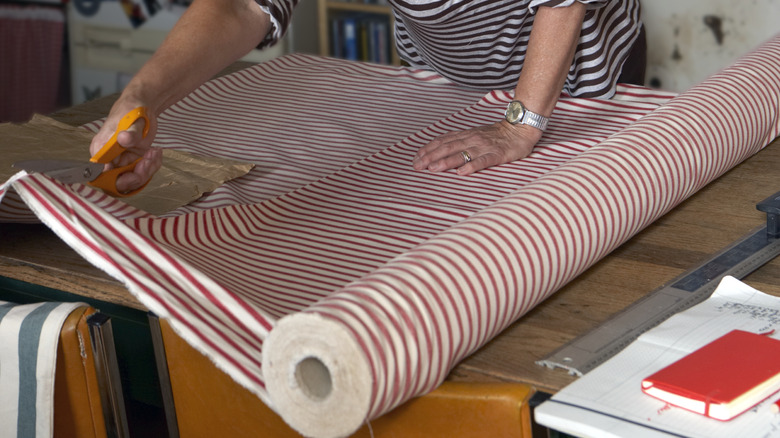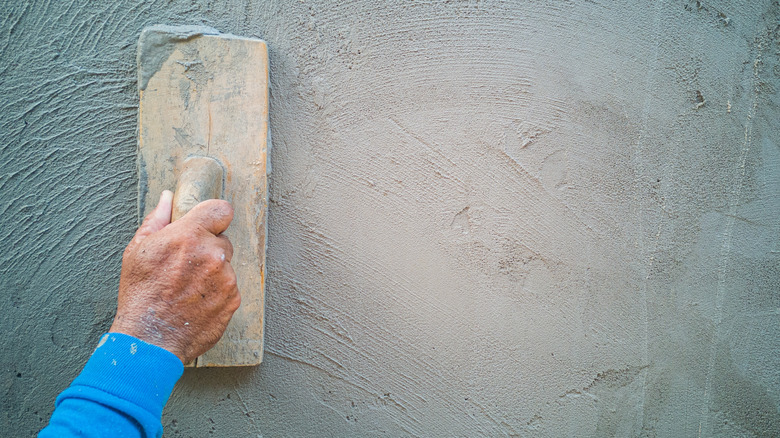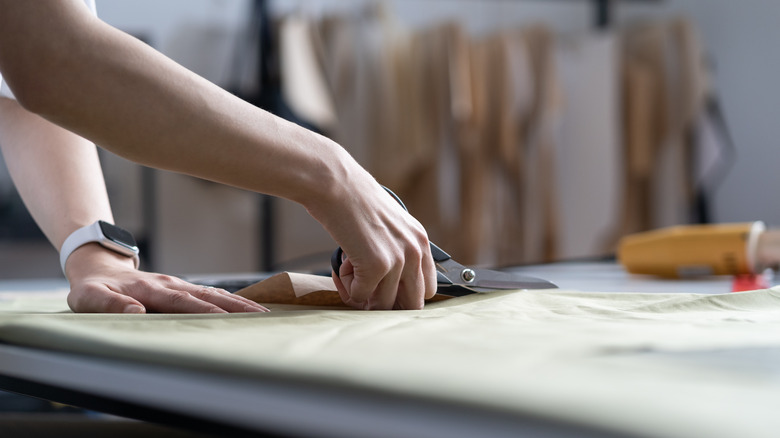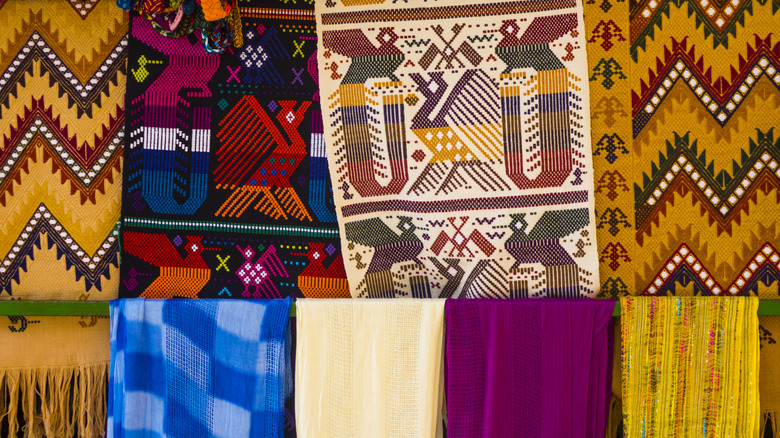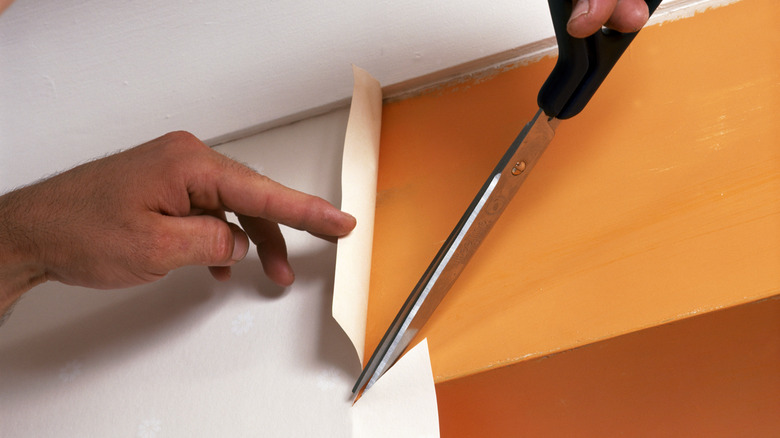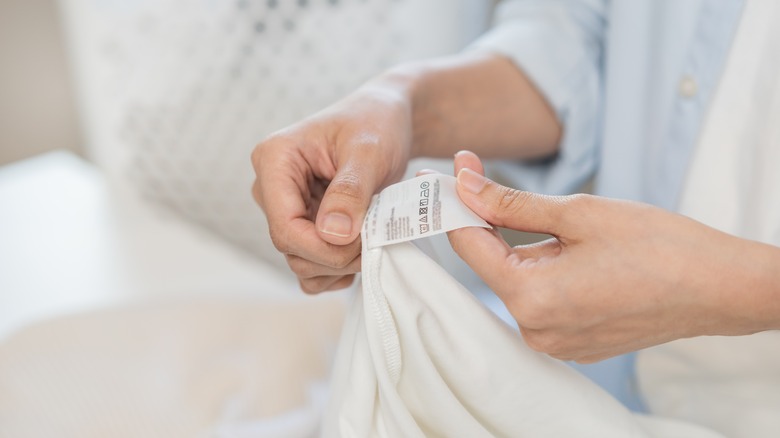How To Get The Fabric Wall Look In Just 5 Steps
The practice of hanging fabrics on the wall has its roots in the 17th century. It was customary for English aristocrats to take woven tapestries with them when they visited their summer homes, per Financial Times. Since then, it's been a common way to add personality to the house. Fabric walls add more texture to a space than paint and wallpaper and are an excellent way to include patterns and color in a room. This creative trend is great for virtually any room in the house — fabric walls can even adorn your basement walls!
Expert Molly Wemyss says a significant characteristic of fabric walls is that they hold the light in the room, unlike walls covered with paper (via Financial Times). They feel comfortable and cozy, which strengthens that sense of being home. They can also be used to hide the cords behind your TV. If you're ready to add this to your home, here are five steps to get the fabric wall look.
Prepare the wall
An important part of preparing the wall is to make sure it is smooth and even so that the fabric can completely lay flat on it. If there are any holes from nails or screws, fill them in and smooth them over. Any outlets should be removed, and the area should be flattened so the wall looks completely bare. For a textured wall, you can skim-coat it by applying two coats of drywall mud mix with a taping knife, per A Piece Of Rainbow.
Two other methods of smoothing a wall in preparation for a fabric wall include sanding it down or using lining paper as a base. Even though it's common to attach the fabric directly to the wall, it's also common to have a layer underneath because it makes it easy to remove later. Wemyss' method involves cleaning the bare wall with whitewash and then screwing on wooden frames, which the fabric will be hung on, via Financial Times.
Prepare the fabric
There are different techniques to get the fabric on your wall. You can staple it, apply it like wallpaper, or upholster the wall. According to Kit Kemp, upholstering is an excellent option for a bedroom as the texture is more pronounced and also soundproofs the room. Whichever technique you choose, the first step to preparing the fabric is to measure how much wall space you need to cover and how much material will do the job.
Expert Wemyss prepares the fabric days before it is installed by drawing up a plan which shows how the fabric pieces will be placed on the wall. After, the fabric is sewn together in the way it will be hung up. Something to note about the seam plan is that the material may not take up the same amount of space when it is put on the wall, per Financial Times. If a strong pattern is involved, another tip is calculating how the fabric pieces need to be cut, so the print matches well on the wall. Fabrics that are light, wide, and non-stretch are ideal, via How to Decorate.
Attach the fabric to the wall
How to Decorate advises starting at the top corner and moving horizontally, fastening in the same spots when stapling the fabric to the wall. If you're applying it like wallpaper, apply the starch to the wall or background material, attach the fabric to it, and smooth it out. Upholstering? Measure how much fabric you need and use a curtain rod to drape it over the wall, according to How to Decorate.
Using velcro strips is another excellent method to attach the fabric to the wall. You won't need to hide them like staples and won't have to smooth the fabric down like the starch technique. It is also a less permanent method, as you can take down the material when needed, says Shiny Modern. First, decide on a side to have the velcro strips. Then, put as many as you need to keep the fabric up on the edge of the fabric, about 4 inches apart. Lastly, stick it to the wall.
Clean up
Cleaning up the fabric wall after it's installed is necessary to make it look as tidy as possible — doing so also elevates the space's aesthetic. This looks like trimming any excess fabric and covering up any showing staples. You can use a scalpel or pocket knife to cut the surplus parts after stapling or when the starch has dried. If you drape the fabric over the wall, you might also need to trim the ends after seeing the final result.
To hide staples, you can cover them with smaller pieces of fabric by sewing or gluing them on. Alternatively, you can make the staples a part of the design by making them into attractive compositions, via DIY Doctor. Decorative trims are another method of covering uneven edges or staples on edges. They break up the pattern flow, which is why extra cuttings of the pattern are usually used to cover edges.
Maintain it well
After installing your fabric wall, it's important to maintain it properly to preserve its quality. Dust and dirt can dull its shine, so clean it regularly. The type of application method you use will determine how often you can clean your fabric wall; how to wash the cloth will also depend on the material. Velcro strips make it simple to take down the material, but most techniques are more permanent and require you to clean the textile while it's still hanging.
De Hygienique recommends regularly dusting or vacuuming the fabric wall and addressing stains immediately. If it can be wet cleaned, soak a sponge in soap and water and squeeze out extra moisture. Go over the fabric in an organized movement to track where you've cleaned. Be careful when wiping down the material or handling stains so you don't shift the fabric. It's also important to know if it's worth cleaning a fabric wall or just replacing it. Mold spots, for example, indicate contamination behind the fabric wall.
